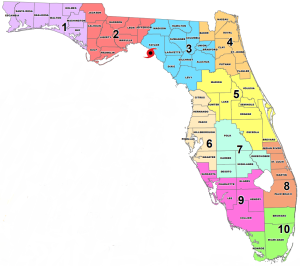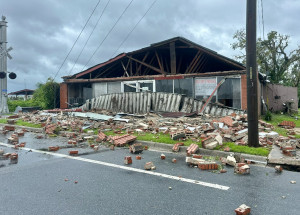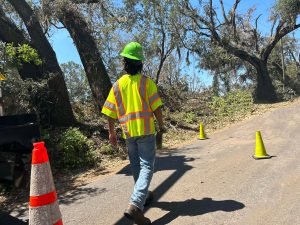Lawmakers hear needs of Idalia’s rural communities, too
In addition to providing more relief for farmers who suffered damage in last August’s Hurricane Idalia (see our Open story), the Florida Legislature in its recent special session also agreed to more funding for a program that helps homeowners fortify their homes against future hurricanes. Meanwhile, an ongoing legislative committee this past week looked at additional ways to help those mostly rural counties especially hard-hit by Idalia.
 Home Hardening: HB 1C was passed and signed into law, which provides for the agricultural relief and another $176 million for the My Safe Florida Home program. The program offers free home inspections and grants of up to $10,000 on a $2 to $1 match to incentivize homeowners to harden their homes from future hurricanes. It also reduces their insurance premiums by an average of $1,000 annually, CFO Jimmy Patronis told lawmakers, because “it’s less of a risk, less likely we’ll be paying a claim.” Last spring the Legislature re-established the original 2006 program with $100 million beginning this past July 1, but the number of applications exceeded that funding by 17,600. The additional funding just passed will take care of that backlog. You can read more in this bill analysis.
Home Hardening: HB 1C was passed and signed into law, which provides for the agricultural relief and another $176 million for the My Safe Florida Home program. The program offers free home inspections and grants of up to $10,000 on a $2 to $1 match to incentivize homeowners to harden their homes from future hurricanes. It also reduces their insurance premiums by an average of $1,000 annually, CFO Jimmy Patronis told lawmakers, because “it’s less of a risk, less likely we’ll be paying a claim.” Last spring the Legislature re-established the original 2006 program with $100 million beginning this past July 1, but the number of applications exceeded that funding by 17,600. The additional funding just passed will take care of that backlog. You can read more in this bill analysis.
 Rural Recovery & Resiliency: When Hurricane Idalia made landfall on Keaton Beach in rural Taylor County as a Category 3 storm, it was the biggest one that part of the Big Bend region of Florida had seen in more than 100 years. Sustained winds of 125 mph extended 25 miles and tropical-force winds another 160 miles, causing widespread damage to the entire Region 3 in blue in the Florida Division of Emergency Management map at right. Storm surge was up to nine feet along the coast. Two people died in traffic accidents just prior to landfall. There’s an estimated $9 billion in total economic damage.
Rural Recovery & Resiliency: When Hurricane Idalia made landfall on Keaton Beach in rural Taylor County as a Category 3 storm, it was the biggest one that part of the Big Bend region of Florida had seen in more than 100 years. Sustained winds of 125 mph extended 25 miles and tropical-force winds another 160 miles, causing widespread damage to the entire Region 3 in blue in the Florida Division of Emergency Management map at right. Storm surge was up to nine feet along the coast. Two people died in traffic accidents just prior to landfall. There’s an estimated $9 billion in total economic damage.

The former Bellamy’s Produce in Perry, FL suffered major damage from Hurricane Idalia, August 30, 2023. Courtesy, Evan Bunkers via @EvanBuWX
The House Select Committee on Hurricane Resilience and Recovery last Monday heard from local officials across the regions. All are from rural, fiscally-constrained counties with limited resources in every way, especially in paid staff. Debris removal is their most immediate issue, with few volunteers left to help. While they thanked DOT for its help with clearing debris, several requested rule changes allowing clearing on some private roads. Most counties are using schools or school parking lots for their Emergency Operation Center (EOC); some are “hardened” but can’t withstand a major hurricane. It also causes issues getting students back to class.
Fuel availability was another big issue. Some counties had 100% power outages which impacted communication. With cell phone towers down and no generator backup, cell service was lost for several days until phone companies brought mobile units. Some rural gas stations that didn’t have transfer switches and generator backup weren’t able to pump needed fuel.

A relief worker clears debris from Hurricane Idalia in Perry, FL., September 6, 2023. Credit, Adrian Holt
The counties told lawmakers that financial assistance to farms has been slow, leaving farmers without the resources to clean up, replant, and mend fences. Some cattle farmers lost cattle due to damaged fences, with others forced to sell off cattle because of containment issues.
The Florida Office of Insurance Regulation reports from last Thursday’s data call that estimated insured losses from Idalia now total $309.5 million on just over 25,000 claims. That’s up from the $287.8 million in losses on 24,500 claims we reported earlier this month. Just over 75% of claims are now closed and maintaining a paid to unpaid claim ratio of 3:2.
LMA Newsletter of 11-20-23

